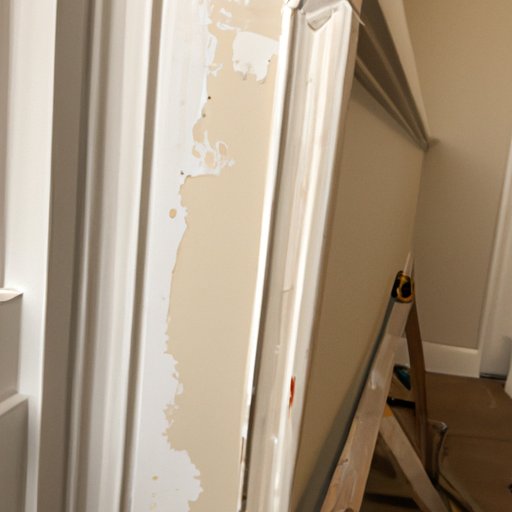Introduction
Chair rail is a type of decorative trim that is placed along the walls of a room at chair-height. It can be used as a way to divide up a wall or create a visual interest in a space. If you’re looking to update the look of your home, removing the chair rail may be a good place to start.

Measuring the Height of the Chair Rail
The first step in removing chair rail is to measure the height of the rail. You can estimate the height by measuring the distance between the floor and the bottom of the rail. Alternatively, you can use a tape measure to find the exact height of the rail.
Once you’ve determined the height of the rail, mark it on the wall with a pencil. This will help you ensure that you’re cutting in the right spot when you start to remove the rail.

Cutting a Horizontal Line Across the Wall with a Utility Knife
Once you’ve marked the height of the chair rail, the next step is to use a utility knife to cut a horizontal line across the wall. Make sure you choose a knife with a sharp blade so that you don’t have to put too much pressure on the wall when you’re cutting.
When you’re cutting the line, make sure that it’s straight and even. This will help you avoid damaging the wall or creating an uneven surface when you remove the chair rail.
Pry the Chair Rail Away from the Wall
After you’ve cut the horizontal line, you’ll need to pry the chair rail away from the wall. Use a flathead screwdriver to identify where the nails are located. Be careful not to damage the wall when you’re doing this.
Once you’ve identified the nails, you can use a pry bar or crowbar to gently pry the chair rail away from the wall. Take your time and be careful not to damage the wall or the chair rail.

Removing the Nails and Filling in the Holes with Spackle
Once you’ve removed the chair rail, the next step is to remove the nails from the wall. Use a hammer and a nail set to carefully remove the nails. The nail set will help you avoid damaging the wall when you’re removing the nails.
After you’ve removed the nails, you’ll need to fill in the holes with spackle. First, prepare the area for spackling by cleaning off any dust or debris. Then, apply the spackle to the holes and allow it to dry completely before sanding the area smooth.
Sand Down the Area and Repaint the Wall
Once the spackle has dried, you’ll need to sand down the area to create a smooth surface. Use a fine-grit sandpaper to lightly sand the area. Then, use a damp cloth to wipe away any dust or debris.
Finally, select the right paint for the job. If you’re repainting the entire wall, make sure to choose a paint that matches the existing color. If you’re only painting over the chair rail, you can choose a different color for a new look.
Installing New Molding or Painting Over the Old Chair Rail
Once you’ve finished painting, you may want to consider installing new molding or painting over the old chair rail. For new molding, make sure to measure the area and buy the right size for the job. For painting, make sure to choose a paint that will cover the existing chair rail.
Conclusion
Removing chair rail is a relatively straightforward process. By following these steps, you can safely and effectively remove your existing chair rail and update the look of your home. Remember to take your time and be careful when you’re working on the wall to avoid any damage.


